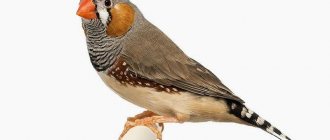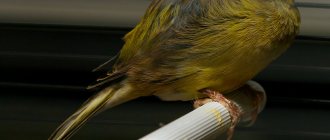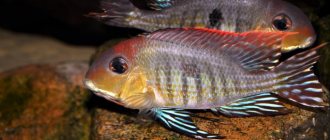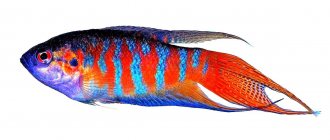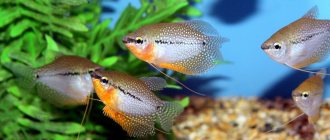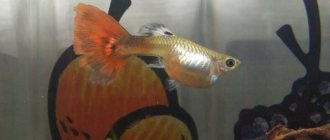Appearance and size of the bird
Zebra finches are tiny birds from the weaver finches family. Their weight does not exceed 50 g, and their body length is only 13-15 cm.
Zebra finches have small black eyes. The expressive thickened and curved beak of this bird appears translucent due to its characteristic waxy tint. Their miniature thin legs are painted in a bright orange hue.
The plumage palette includes 4 primary colors: gray, white, orange and black.
- the belly and undertail of zebra finches are snow-white;
- the back, head and wings of birds are gray;
- there are black stripes on the neck, around the beak and near the eyes;
- There are bright carrot spots on the birds' cheeks and under their wings.
How to distinguish a female from a male
Although there are no significant differences between different sexes of zebra finches, the description of the male includes several characteristic features:
- the plumage is expressive and contrasting;
- sides chestnut with white spots;
- the tail is striated;
- cheeks with bright spots;
- from the beak to half the chest there is a “tiger” pattern, ending with a black spot.
The plumage of females is painted in less bright and saturated colors. They do not have chestnut patches or zebra stripes on their chests.
The sex of birds can also be determined by size. Males are usually larger than females. In addition, they have a thicker and brighter beak with a barely noticeable hump.
On a note. The chicks have the same inconspicuous appearance, so it is possible to accurately determine the gender of the young only after molting.
Problems with instincts
If a week has passed after the laying of the third or fourth egg, and the birds’ parental instincts have not awakened, the eggs along with the nest will have to be removed. In a month the attempt can be repeated. If you still haven’t managed to make parents out of your birds, you have two options. Either stop using them for breeding, or use the services of nurse birds.
Japanese finches perform this role very well. They are mated at the same time, and then the original eggs are carefully replaced with abandoned ones. Do this when the foster parents are not in the nest. Do not touch the eggs with your hands - use a plastic spoon. You can use the services of any other pair of finches who know how and love to hatch and feed their chicks.
Owners who have started breeding Gould finches often encounter this phenomenon. These birds are considered bad parents. In nature, when a drought begins in the place chosen by Gouldian finches for nesting, they fly away following the rains. Left without warmth and care, the chicks die, sometimes without even seeing the light of day.
The situation was aggravated by Japanese breeders who were the first to decide to domesticate this species. It was they who found a way out in adoptive parents. But by laying eggs under other good hens, they only increased the irresponsibility of Gould's finches.
It is worth noting that not all “guilders” in a row turn out to be bad parents. Some individuals still inherit nesting reflexes from their ancestors. Such specimens can be found among experienced breeders who spare no effort in breeding pure lines of Gouldian finches.
Keeping at home
Zebra finches are unpretentious birds; they easily adapt to life in a cage. Therefore, care and maintenance in captivity will not cause much trouble. To make zebra finches feel comfortable, the air temperature in the room is maintained at 20-24 °C and humidity at 50-70%.
These exotic birds fall asleep at sunset and wake up at dawn. To prevent them from creating unnecessary noise, bright lights should not be used in their room in the evenings. In addition, blinding lighting causes depression in finches.
Important! Lack of light provokes metabolic failure and the development of rickets. Therefore, in winter, an additional source of lighting is placed next to the cage, and in summer, the bird is taken out to the balcony.
Arrangement of the cage
The zebra finch does not need a huge enclosure and will be quite satisfied with a standard cage, the dimensions of which are 20x25x25 cm. A house for a pair of birds should be twice as spacious. Finches are very aggressive. Therefore, no more than a couple of birds are placed in each cage.
Zebra finches usually do not chew the bars of their house, so the material from which it is made can be anything. These birds feel equally good in wooden, plastic, metal and combined cages.
Amadins should be placed only in rectangular cages, then they will not be disoriented in space.
To prevent tiny finches from flying out of the home or getting stuck between the rods, the gap should be no more than 1 cm. Inside the finches’ home there must be:
- perches with a diameter of 9-10 mm;
- drinking bowl that closes better;
- feeders for food and mineral supplement.
If you purchase a cage with a retractable tray for zebra finches, this will make the cleaning process easier.
Care
Zebra finches' cages are treated monthly with disinfectant solutions and then washed with soap and hot water. The sand in the pan is changed at least once a week, and the new one is first disinfected with a 2% solution of chloramine with carbolic water. Perches and feeders are treated daily with the same product.
So that birds can carry out water procedures, open hanging bathing baths with sides no more than 2 cm high are placed in their cages. They are filled with boiled or settled water. Bathing zebra finches is especially important during the molting period. It occurs twice a year and causes significant discomfort to the birds. At this time, finches are in a depressed state and require special care. Therefore, during the molting period, it is important for them to provide daily bathing, during which the exfoliation of the epidermis improves.
Feeding
Zebra finches are not picky eaters. They readily eat commercial mixed grains labeled “for exotic birds” and homemade millet-based mixtures.
The following are added to the feed as additional components:
- seeds of meadow and weeds;
- Chumizu;
- hemp;
- flax seeds;
- cereals;
- crushed sunflower.
In addition to seeds, succulent food is introduced into the birds’ diet. Zebra finches are given greens, berries, vegetables and fruits daily. Dry and wet food are placed in different feeders so that the grains do not become soggy and spoil.
Important! Exotic birds are not recommended to be given fragrant greens such as basil, dill or onions.
Separately from the food, zebra finches are given mineral supplements in the form of pebbles, chalk and sand. They are needed not only to improve digestion, but also to stimulate feather growth and prevent brittleness of claws, beak and bones.
In addition to plant foods, birds are given food of animal origin. Eggs, cottage cheese, gammarus and bloodworms are introduced into their diet as a source of protein.
Lifespan and reproduction in captivity
The lifespan of these birds depends on care, nutrition, housing conditions and genetics. In the natural environment, zebra finches live 8-10 years. At home, a pair of different-sex birds can live up to 15 years.
In the wild, zebra finches live in large flocks, within which pairs form. Amadins are very prolific and reproduce well in captivity. They become sexually mature at six months and can produce offspring regardless of the season. For breeding, it is better to choose young animals that are under 12 months old.
The selected pair is placed in one cage and they wait until the birds get used to each other. If the male begins to sing mating songs, then soon we can hope for the appearance of chicks.
Since finches are very shy, it is better not to disturb them during the mating period. And so that the birds have something to build a nest from, fluff, dust, straw, hay, twigs and other building materials are placed in the cage.
At one time, the female lays from 2 to 7 eggs. And the process of hatching chicks lasts 14-16 days. Both parents hatch the eggs.
The chicks are born defenseless, blind and very vulnerable. They are small in size and covered with sparse down. A week after birth, finch chicks begin to open their eyes, and after another 14 days they leave the nest for the first time. By this time, they have time to acquire feathers, and some can even fly.
After this, the parents feed them for another 2-3 weeks.
On a note. The main indicator of the maturity of young animals can be considered the increase in the noise they make.
Better in summer than winter
For breeding finches, it is better to choose the spring-summer season, when you can get natural vitamins. Collect greens, collect milk ears, meadow grass seeds, grow your own grain feed. Also in spring and summer there are long daylight hours, fresh air and enough sunlight necessary for the normal functioning of birds.
Finches can also reproduce in the autumn-winter period. But then in the room designated for nesting, the temperature will have to be maintained at 20-25 degrees above zero. For Gouldian finches it should be raised to 30 degrees.
It is also necessary to artificially increase daylight hours to 16 hours. This should be done gradually, adding 20-30 minutes per day. Fluorescent lamps or fluorescent lamps will help you cope with the task.
All year round, the air humidity in the room where birds nest should be maintained at 55-70 percent. It's good if you take care of your air quality with a purifier. Especially in autumn and winter, when it is impossible to ventilate the room, because drafts are contraindicated for finches.
How to choose a bird
It is advisable to purchase zebra finch not from pet stores, but from trusted breeders. It is better to purchase a finch in the fall, so that it has time to get stronger and adapt over the winter.
Preference should be given to moderately well-fed, active individuals with clean, non-sticky feathers around the cloaca, pinkish skin, even breathing, shiny eyes and springy energetic movements.
On a note. Emaciated, lethargic finches with a protruding breastbone, ruffled feathers, or bald patches may be diseased. It is better to refuse to buy them.
Zebra finches are active and cheerful birds. They do not require complex care, get along well with people and will be excellent pets for those who do not like silence and are willing to put up with constant background noise.
Life in freedom
Zebra finches are gregarious birds. Their range extends to the entire region of Australia (with the exception of the northern regions), Africa, southern Asia and the Lesser Sunda Islands. They are also found in the USA, Portugal, and Puerto Rico, where finches were brought by sailors.
In nature, they prefer to settle near bodies of water in thickets of bushes, in the crowns of trees in flat areas, and in tall grass. Finches also get along well next to people in city parks. They feed on the seeds of various plants and grasses.
During the nesting period, they form pairs within the flock (up to 20-25 pairs in one flock at the same time). Zebra finches nest wherever they can: in hollows and treetops, in empty nests made by other birds, and even in rabbit holes.
Taking care of your health
Amadins are susceptible to all the same diseases as most birds. The right way to take care of your health is to have a balanced diet and ensure long daylight hours. If you carefully monitor your pets, they will always be healthy and active.
The first signs of disease
The first signals of a disease may be a decrease in activity in birds. Apathy, half-open eyes, wheezing and ruffled feathers are also a signal that something is wrong with the bird.
The first thing to do is to put the “sick” in a separate cage, then go to the veterinarian.
